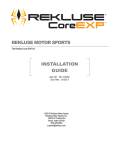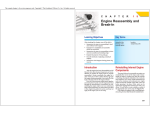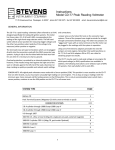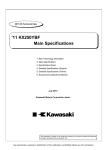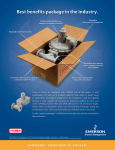Transcript
TECH TIP CHECKING VALVE CLEARANCE ON KX250F With 4-Stroke Motocross bikes becoming ever so popular and more common among consumers, and as manufactures keep striving to build lighter and faster bikes, periodic maintenance becomes more important than ever. 4-Stroke motors definitely have a lot more going on and with a ton more moving parts than that of a 2-Stroke, Each of those parts can affect the bikes performance in different ways. One crucial maintenance item to keep up on [one that many of us that have ridden 2-Stroke’s for years have never dealt with] is, maintaining proper valve clearance. This teen-tip is the first part of a two part series on maintaining proper valve clearance for optimum performance. In this issue of INSIDE TEAM GREEN we will cover “How to check valve clearance.” This will be followed up by “How to adjust valve clearance” in the next issue. ■ TOOLS NEEDED: ● 8mm socket wrench ● 6mm Allen ● 10mm socket wrench ● Flat Blade screw driver ● 14mm socket wrench ● Feeler gauges ● 5/8 spark plug wrench Step 7: Using feeler gauges and the Go/No-Go method of checking clearances, check valve clearance on both cams. Be sure to make note of clearances on each cam. The Go/No-Go method of checking clearances means that if the clearance is supposed to be between .004 and .006 (4 thousands and 6 thousands), then it should take the .004 but not the .006. Step 4: Remove the two timing inspection hole caps. [Left side motor] Fig. A: Valve clearance is the distance between the cam lobes (A) and the lifters or tappets (B). Step 5: Use a 14mm socket wrench to rotate the crank shaft counter clockwise to find top dead center [NOTE - Finding top dead center on compression stroke, and why] Top-dead-center at the end of the compression stroke is when alt the valves are closed and the cam lobes face upwards (seen above in Figure A). TEAM GREEN RECOMMENDED CAM CLEARANCE (Stock cams) ● Intake - .004 to .006 in or .1 to .15mm ● Exhaust - .007 to .009 in or .17 to .22mm * If the valve clearance is not within the specified range, adjust it. [adjusting valve clearances will be covered in next issue, or refer to model service manual] Step 1: Remove necessary body work (seat, tank shrouds, etc) so that you have good clear access to the top end of the motor. Step 2: Remove spark plug. This will relieve compression and make it easier to turn the crank and find top dead center. Step 3: Remove the valve cover, and valve cover gasket. [Two 6mm Alien headed bolts] Fig. B: Additionally the dots (A &B) on each camshaft should line up with top surface of cylinder head (C). Marks on the flywheel should also line up in middle of timing inspection hole. [Note] Intake cam is closest to carb. or rear of bike. Exhaust cam is furthest from carb., closest to front of bike (also displayed in Figure B). Step 8: Reassemble bike and ride WHAT IF ??? CAUSE AND EFFECT Valve too tight – Hard starts, poor and erratic idle, lack of performance, and hesitation at low RPM. ● Valve too loose – Noisy, lack of performance, Hard on valve train, causing excessive wear on cam shaft and tappets (lifters). ● [NOTE] Ideally you want to run the clearances as close to the loose end of specification as possible. Result will be easier starts, bums fuel better, and improved throttle response at low RPM’s. Valves typically do not loosen over time and use. They typically tighten up. Watch for next issue on “Valve Adjustment” Material courtesy of Team Green News USA




